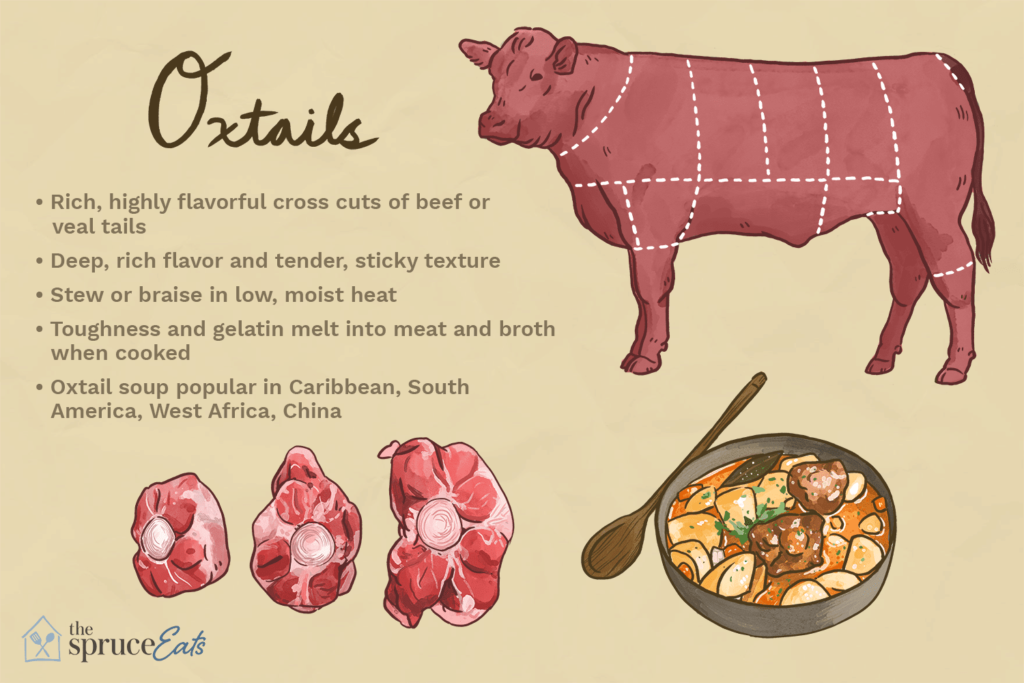Oxtail is a boney cut of beef that was traditionally discarded or sold cheaply to those who could not afford the more preferred cuts. Today, it is often a sought after delicacy.
Cooks use low heat and long cooking time to break down the oxtail’s connective tissue, which results in a flavorful broth. It is also rich in collagen and fat, which melts as the meat simmers.
Overview of Oxtail as a Food Source
Oxtail is meat that comes from the tail of a beef cattle or veal cow. It has a lot of bones and marrow in the middle surrounded by meat and fat.
It can be eaten raw, cooked, and even served as a soup. It has a lot of collagen, which is very important for our bodies.
It is a good source of protein, vitamins, and minerals. It is a healthy alternative to red meat and can help you lose weight.
Culinary Uses and Traditional Dishes
Oxtail is used as a cut of meat in many culinary traditions. It can be prepared as a soup (in Russia, West Africa, Spain and Korea), a stew (e.g. coda alla vaccinara in Rome and rabo de toro in Cuba) or as a stewed dish (such as Jamaican oxtail soup).
It has a high collagen content, which produces a rich, gelatine-rich meat that is ideal for use in stock and bone broths. It is also a popular choice for braising and stewing dishes.
It is a low-fat and lean alternative to beef short ribs. It is also a great source of protein, iron, and calcium. Unlike most cuts of beef, it can be made into a variety of savory recipes with ease, including soups and stews.
Availability and Market Trends
Oxtail has a long and illustrious culinary history, and it is a staple of many cultures. However, it is also one of the most expensive cuts of meat available.
In most markets, a pound of oxtail can cost anywhere from five to ten dollars. This is due to its limited availability and high demand.
This is especially true during the winter and autumn months, when hearty stews and soups are in higher demand. In those times, oxtails are usually more expensive than during warmer seasons.
Health Benefits and Concerns
Oxtail is considered a healthy food source because it has high protein, iron, and collagen content. It is also an excellent source of vitamins and minerals.
It is a good choice for people who are trying to lose weight or follow a low-fat diet. However, the meat can be high in fat, so portion control is essential.
Oxtail is also a rich source of protein and minerals like iron, zinc, calcium, phosphorus, magnesium, and selenomethionine. These nutrients are important for bone health, muscle growth, and energy production.
Sustainability Issues
Many consumers are looking to incorporate more healthy and environmentally-friendly meats into their diet. However, it can be difficult to find affordable meats that are also ethically raised. As a result, some people are turning to alternative meats like yak and oxtail.
Oxtail is a gelatine-rich meat with a silky texture that works well in soups and stews. It can be prepared in a variety of ways, including slow-cooked oxtail stew, wine-braised oxtail or Southern smothered oxtail. For the best results, it is recommended to cook oxtail in a low and slow oven. It is also a good idea to make the oxtail ahead of time and store it in the refrigerator until you are ready to use it. This will help to ensure that it is tender and flavorful.

